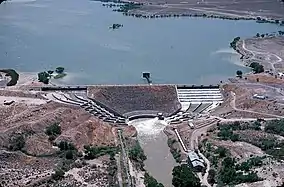Lahontan State Recreation Area
Lahontan State Recreation Area is a public recreation area surrounding Lake Lahontan, a 17-mile-long (27 km) impoundment of the Carson River,[3] located approximately 18 miles (29 km) west of Fallon, Nevada.[4] The reservoir features 69 miles (111 km) of shoreline and 11,200 acres (4,500 ha) of water when full.[5] Much of the park lies below 4,000 feet (1,200 m) in elevation and is dominated by high desert sagebrush. Wooded areas of native cottonwoods and willow trees can be found along the shore of the lake.[6] Primary access points to the park are along U.S. Route 50 near the Lahontan Dam and off U.S. Route 95 in the town of Silver Springs.[4] A corridor known as Carson River Ranches connects Lahontan with Fort Churchill State Historic Park.[7]
| Lahontan State Recreation Area | |
|---|---|
 Lahontan Dam on the Carson River | |
 Location in Nevada | |
| Location | Lyon County and Churchill County, Nevada, United States |
| Nearest city | Fallon |
| Coordinates | 39°24′03″N 119°07′33″W[1] |
| Area | 28,892.3 acres (116.923 km2)[2] |
| Elevation | 4,258 ft (1,298 m)[1] |
| Designation | Nevada state recreation area |
| Established | 1971 |
| Administrator | Nevada Division of State Parks |
| Website | Lahontan State Recreation Area |
History
Following passage of the Newlands Reclamation Act of 1902, the Lahontan Dam was constructed along the Carson River between Fallon and Carson City. The dam, measuring 162 feet (49 m) high and 1,700 feet (520 m) long, was completed in 1915. The reservoir was named after ancient Lake Lahontan which covered much of Nevada during the last ice age. Submerged beneath the water were parts of stagecoach routes which existed during the 1800s including Williams Station, the scene of the Battle of Williams Station, a minor skirmish during the Paiute War. Originally operated by Churchill and Lyon counties, Lahontan became a state-operated recreation area in 1971.[4]
Activities and amenities
Park activities include boating, water skiing, fishing and camping. The park has two developed picnicking areas as well as a developed campground at Silver Springs Beach #7. Primitive camping is allowed in most other areas.[8] Multiple trails can be found along the length of the reservoir.[9]
References
- "Lahontan State Recreation Area". Geographic Names Information System. United States Geological Survey.
- "Inventory of State Lands" (PDF). Nevada Division of State Lands. May 2016. Archived from the original (PDF) on February 5, 2018. Retrieved January 29, 2018.
- "Lahontan Reservoir". Nevada Department of Wildlife. Retrieved November 21, 2019.
- "Lahontan State Recreation Area". Nevada State Parks. Department of Conservation and Natural Resources. Archived from the original on January 22, 2013. Retrieved November 21, 2019.
- "Lahontan Reservoir". Recreation.gov. Retrieved November 21, 2019.
- "Lahontan State Recreation Area". Nevada State Parks. Department of Conservation and Natural Resources. Retrieved December 21, 2016.
- "Hunting Information for Lahontan State Recreation Area" (PDF). Nevada State Parks. Department of Conservation and Natural Resources. Retrieved November 21, 2019. See map.
- "Lahontan State Recreation Area Brochure" (PDF). Nevada Division of State Parks. July 2013. Archived from the original (PDF) on December 21, 2016. Retrieved December 21, 2016.
- "Chapter 5: Inventory" (PDF). Nevada 2005 State Recreational Trails Plan. Nevada Division of State Parks, Planning and Development Section. pp. 69–77. Archived from the original (PDF) on December 21, 2016. Retrieved December 21, 2016.
External links
| Wikimedia Commons has media related to Lahontan State Recreation Area. |
- Lahontan State Recreation Area Nevada State Parks